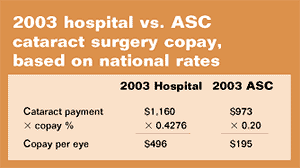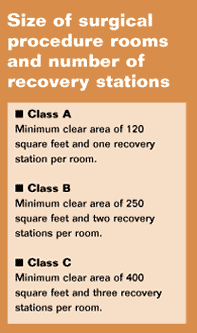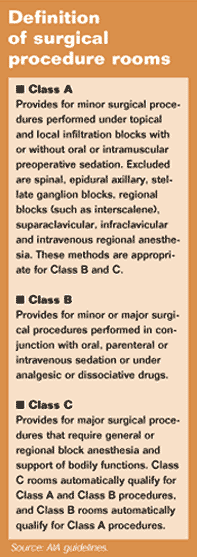Ambulatory surgery center startup requires planning
If you are considering opening an ambulatory surgery center, here are some key questions to answer as part of the planning process.
Because it allows a physician to control scheduling, cost and quality, an ambulatory surgery center (ASC) should be on the “must consider” list of every ophthalmologist without one.
Ophthalmologists who have their own surgery center have found that a properly planned ASC can generate an additional revenue stream from existing patients, with no increase in their workload.
By being able to control their surgery schedule and streamline operating room turnover, these physicians have additional time to either see more patients — resulting in more revenue — or simply enjoy more leisure time with family and friends.
Planning efforts for ASCs generally focus on the ophthalmologist’s surgical caseload and whether they can afford to add an ASC. Other potentially important considerations may be overlooked.
In my engagements with surgeons interested in ASC development, I pose the following questions I have found to be valuable in the decision-making process.
Where do you currently perform surgery?
Hospital: If the physician performs surgery at a hospital, the Medicare payment system for hospital outpatient services (Ambulatory Payment Classifications, or APCs) could dramatically affect future opportunities to perform cataract surgery at these facilities.
Historically, hospitals were reimbursed their costs for delivering outpatient services, and neither made a profit nor lost money on cataract surgery.
With the implementation of APCs in August 2000, hospitals now had an opportunity to make or lose money on cataract surgery as cost reimbursement was replaced with a prospective rate.
Because these rates were based on median costs, half the hospitals in the country automatically made money on cataract surgery and the other half lost money.
Hospitals that lost money could decide to discontinue cataract surgery as a product line or severely restrict supplies and pharmaceuticals, new equipment and the availability of prime operating room hours.
Due to the historical charge structure used by hospitals, resulting coinsurance percentage at hospitals for cataract surgery can be more than double the coinsurance percentage at ASCs.
Clearly, ASCs have a decided advantage for patients responsible for some or all of their supplemental facility coverage, and could be marketed by surgeons having their own ASCs or those contemplating building one.
Using 2003 national rates for hospitals and ASCs, cataract surgery costs the patient (or their supplementary insurance) approximately $301 more per eye to have cataract surgery performed at a hospital rather than an ASC (see sidebar).
Multispecialty ASC: If the physician is using a multispecialty ASC, a hospital comparison may not apply because ASCs have always been paid on a prospective rate basis.
Should the physician be an investor in a multispecialty ASC, the noncompete section of the operating agreement should be thoroughly reviewed if they are considering developing their own center.
The provisions of the noncompete may not allow physicians to build in the geographic location desired. They may have to sell their membership interest in the multispecialty ASC and wait a specific period of time before building their own ASC. The legal language is sometimes so restrictive for the surgeon that they may feel prohibited from building entirely.
Who will use the ASC? Who might use it?
The configuration of the ASC is often based on the type and number of ophthalmic procedures outlined in the financial feasibility study. If the architect is instructed to hold construction costs to a minimum, they will design the center in the most cost-effective manner to accommodate these procedures. Unless expansion of services has been factored into the planning process, this may well be a mistake.
As a rule, any surgeon building their own ASC will be approached (either before or after the project is completed) by other surgeons who are interested in becoming a part of the ASC as users and possibly investors, including surgeons in other specialties. “Build it and they will come” is alive and well in the world of ASCs. Planning should include discussions on the implications for future users who may have operating needs that are different from those of the ophthalmic surgeon initiating the project.
While Medicare certification requirements are uniform nationwide, state licensing standards vary widely. Some states use the American Institute of Architects (AIA) Guidelines for Healthcare Facilities as the standards to follow in their regulatory process. Under these guidelines, the type of anesthesia used dictates the required size of the OR and the number of recovery stations.
Underbuilding within these guidelines could limit the potential for use by other surgeons (the requirements under the AIA guidelines are detailed in the sidebar). For this reason, a decision might be made to expand the scope of the project and build out the ORs and recovery stations to Class C specifications even though the ophthalmic surgeon needs only a Class B buildout.
Medical gases and vacuum: While many ASCs use piped medical gases and a central vacuum system, these are generally not necessary for cataract cases. However, other specialties performing general anesthesia cases could require piped gases and central vacuum.
Clean and soiled utility: These areas require only a minimum space for cataract cases, but for other specialties, such as orthopedics, larger areas are needed.
Patient age mix: If pediatric surgery will be part of the ASC services, separation from the adult section and space for parents may be required. Sound attenuation of the area and the ability to view patients from the nursing stations should be considered.
Because many ophthalmic ASCs have excess capacity, configuration of the ASC to accommodate other specialists may in the long run be the optimum course of action. Should ASC rates decrease, the ability to have non-ophthalmic cases performed in the ASC could offset income loss or even increase overall income as overhead costs are spread over additional cases. Multispecialty capability also increases the pool of potential purchasers for the ASC, thereby increasing the value of the ASC.
What is your exit plan for your ASC?
No one should enter an investment without having an exit plan. Sometimes overlooked in the excitement and activity of ASC development is the manner in which the ASC will be legally held and the plan by which the owner will most likely divest of the ASC. 
I generally recommend that the real estate (land and improvements) be owned by one legal entity and that the operations portion of the ASC be owned by another legal entity. Under this configuration the operating company leases the real estate (land and buildings) from the real estate company. Usually, the original developers of the ASC own both entities and set up a triple net lease that will cover their debt service and generate a return on their investment.
Retire with passive income: If the exit strategy of the original owner is to ultimately retire and receive passive rental income from the real estate portion of the ASC, then new physicians may be allowed to invest in the operating entity but not in the real estate entity.
Upon retirement from the active practice of medicine, ownership in the operating entity is sold but the ownership interest in the real estate entity is retained.
The ability to buy into an ASC without having to purchase the real estate can be very attractive to a junior physician and can be structured as a portion of the retiring physician’s practice exit strategy.
This approach can also be used effectively in estate planning, as the real estate entity may be gifted to children, placed in trust or donated to a qualified charity.
Because the operating entity holds the state license and the Medicare certification, a long-term lease or restrictions on the ability of the acquiring surgeon to build another center and move the surgical operations should be addressed in the sales agreement of the operating entity.
Relocation of the operating entity could have an extremely negative effect on the rental value of the vacated ASC. The older physical plant may not meet later state licensing requirements and may not be eligible to be relicensed as a surgery center.
Retire and sell both operations and real estate: This structure can also work well as an exit strategy, as the real estate may be sold to the surgeons acquiring the ASC or it may be sold to an investor that is interested in the income stream from the real estate.
Regulatory impact: Some states have regulations that may not permit the surgeon to use this separate ownership structure as described. For example, the Certificate of Need (CON) legislation in some states exempts single-specialty surgery centers from CON review if the ASC is held inside the practice legal entity. A review of CON requirements is essential for each state.
The time to plan is now
An ASC that is licensed to perform a wide range of approved ASC services is a valuable commodity.
Surgeons performing their cases in a hospital should be wary and look for hints that the value of their cases to the hospital may be declining.
If you are considering an ASC, the additional cost to design the ASC to accommodate different specialties should be weighed against the potential for lost revenues by not doing so.
Giving thought to your potential exit plan may alter the manner in which you initially configure your legal entities, the manner in which new members are admitted and the structure of your eventual sales arrangements.
If you are contemplating an ASC, determining how you will handle these and many other issues will require time and sound advice from experienced consultants. In the end, proper upfront decision making is well worth the effort.
For Your Information:
- M.L. Revelett, CPA, CFP, is chief operating officer of Laser & Surgery Centers of America, LLC, and specializes in the development and management of ambulatory surgery centers. He can be reached at 4110 Parliament Drive, Alexandria, LA; (318) 442-5479; fax: (318) 442-5346; email: mlrevelett@cox-internet.com.
